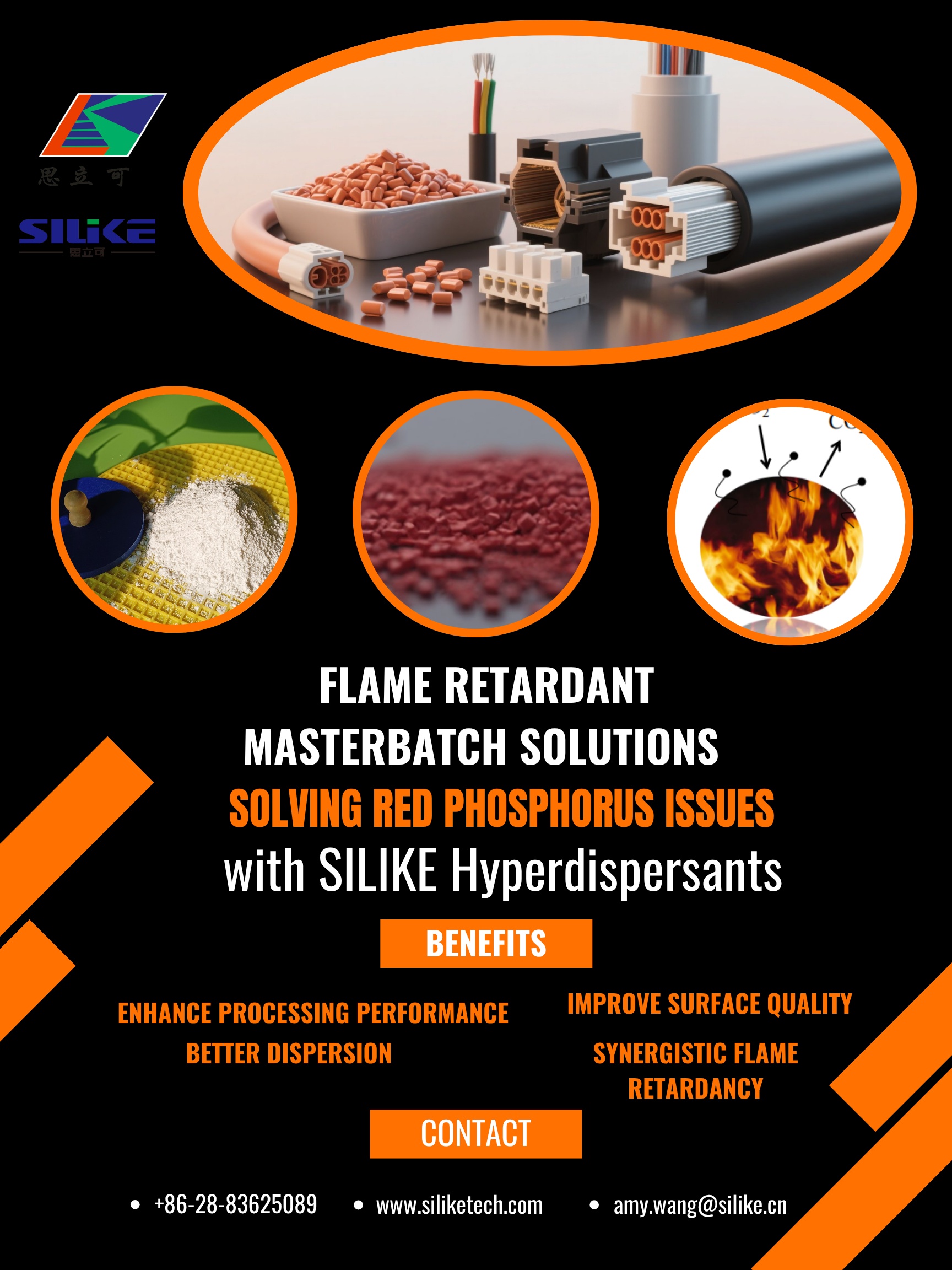Red phosphorus masterbatch is a halogen-free flame retardant designed for integration into plastics and polymers to enhance fire resistance. It is produced by dispersing red phosphorus—a stable, non-toxic allotrope of phosphorus—into a carrier matrix. Common carriers include engineering thermoplastics such as polyamide (PA6, PA66), low-density polyethylene (LDPE), ethylene-vinyl acetate (EVA), and even liquid media like water, phosphate esters, epoxy resins, or castor oil.
As a non-halogenated system, red phosphorus masterbatch is environmentally friendly and compliant with transportation and safety regulations such as ADR, as it is not classified as flammable or hazardous during shipping.
It is especially suitable for engineering plastics like PA6, PA66, and PBT, offering highly efficient flame retardant performance. However, its effectiveness depends heavily on proper dispersion within the polymer matrix. Uniform dispersion ensures consistent flame retardancy, processing stability, and product safety. In this article, we explore what red phosphorus masterbatch is, why dispersion is critical, and the key methods to improve it for enhanced performance in demanding applications.
Understanding Red Phosphorus in Flame Retardant Plastics
Red phosphorus works by promoting the formation of a stable char layer that insulates the polymer and prevents further combustion. Unlike traditional halogen-based flame retardants, it releases minimal smoke and toxic gases, making it ideal for applications requiring eco-compliance (e.g., RoHS, REACH).
Masterbatch form improves handling, reduces dust hazards, and ensures more consistent dosing. However, without proper dispersion, its benefits can be severely compromised.
Why Dispersion is the Key to Red Phosphorus Masterbatch Performance?
• Poor dispersion can result in:
– Uneven flame retardant effect
– Surface defects or scorching during extrusion/molding
– Agglomeration leading to weak mechanical performance
— Corrosion of metal components in processing equipment
• Well-dispersed red phosphorus ensures:
— Stable flame retardant efficiency
— UL 94 V-0 compliance
— Better mechanical properties
— Lower corrosion risk and longer equipment life
How to Improve Dispersion of Red Phosphorus Masterbatch?
Several methods are widely adopted in the industry to enhance the dispersion quality:
1. Use of Dispersion Aids
Processing additives like silicone-based additives,wetting agents or compatibilizers can further help prevent agglomeration and improve processability.
Solve Dispersion Challenges in Red Phosphorus Masterbatch with SILIKE Silicone Hyperdispersants

At SILIKE, we offer advanced dispersion aids specifically designed to enhance the performance of flame retardant masterbatch formulations—including phosphorus-nitrogen systems and antimony-bromide flame retardants.
Our SILIMER Series, a range of innovative silicone-based waxes (also known as silicone hyperdispersants), is engineered to deliver exceptional dispersion of pigments, fillers, and flame retardants during masterbatch production. These additives are ideal for use in flame retardant systems, color concentrates, filled compounds, engineering plastics, and other high-demand dispersion processes.
Unlike traditional thermoplastic additives such as waxes, amides, and esters, SILIMER hyperdispersants provide excellent thermal stability, processing efficiency, and rheological control, while avoiding common issues like migration and blooming.
Introducing SILIMER 6150: Hyperdispersant for Flame Retardant Applications
SILIMER 6150 is a modified silicone wax designed for the surface treatment of inorganic fillers, pigments, and flame retardants, significantly improving their dispersion properties.
It is suitable for a wide range of thermoplastic resins, including TPE, TPU, and other thermoplastic elastomers. By enhancing powder distribution, SILIMER 6150 improves both processing performance and surface smoothness of end products.
Top Benefits of Using SILIKE SILIMER 6150 in Red Phosphorus Masterbatch Formulations
— Higher Filler Loading & Better Dispersion
Prevents clumping by promoting uniform distribution of flame retardants within the masterbatch. This leads to better flame retardant performance and a synergistic effect when used in red phosphorus systems.
— Improved Surface Quality
Enhances gloss and smoothness; lowers coefficient of friction (COF).
— Enhanced Processing Performance
Increases melt flow rate, improves mold release, and boosts production efficiency.
— Excellent Color Strength
Improves color uniformity with no adverse impact on mechanical properties.
2. Use of Coated or Encapsulated Red Phosphorus
Special coating technologies—resin-based, melamine, or inorganic encapsulation—help isolate red phosphorus particles and improve their compatibility with the polymer matrix.
3. Carrier Resin Compatibility
Choosing a carrier resin with similar polarity and melting behavior to the base polymer (e.g., PA-based carrier for PA66) enhances melt blending and homogeneity.
4.Twin-Screw Extrusion with High Shear
Twin-screw extruders with optimized mixing zones promote uniform distribution of red phosphorus during masterbatch production.
Struggling with Dispersion Issues in Flame Retardant Formulations?
Talk to the SILIKE technical team to explore high-performance, safe, and well-dispersed processing aids—including silicone-based wetting agents, lubricants and dispersing agents—tailored specifically for red phosphorus masterbatch applications.These polymer processing aids play a vital role in improving manufacturing efficiency. They help:
• Prevent agglomeration
• Ensure uniform dispersion of flame retardants
• Improve melt flow and surface quality
SILIKE silicone-based hyperdispersants have become essential in overcoming the challenges of poor dispersion in flame retardant masterbatch formulations, enabling better performance and stability.
FAQ
Q1: What is red phosphorus masterbatch used for?
A: It is used in halogen-free flame-retardant applications for PA6, PA66, PBT, and other engineering plastics.
Q2: Why is dispersion important in red phosphorus masterbatch?
A: Uniform dispersion ensures consistent flame retardant performance, minimizes equipment corrosion, and improves processing efficiency.
Q3: How can dispersion of red phosphorus be improved?
A: Through encapsulation, compatible carrier resins, twin-screw extrusion, and use of SILIKE dispersion aids or processing lubricants.
(Learn More: www.siliketech.com | Email: amy.wang@silike.cn)
Media Contact
Company Name: Chengdu Silike Technology Co., Ltd.
Email: Send Email
Country: China
Website: https://www.siliketech.com/
